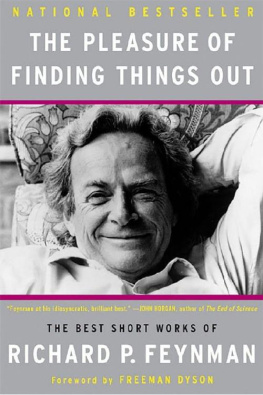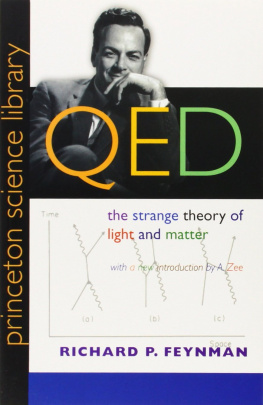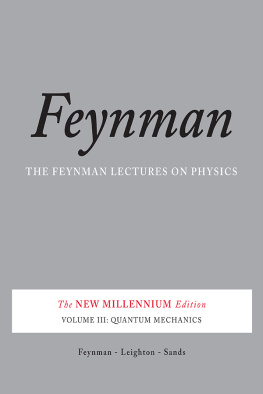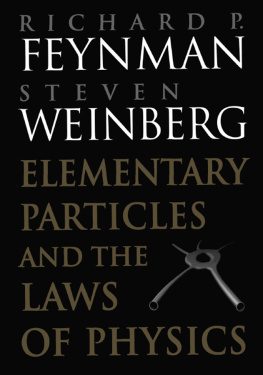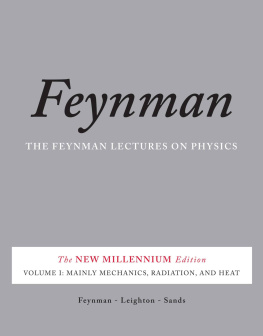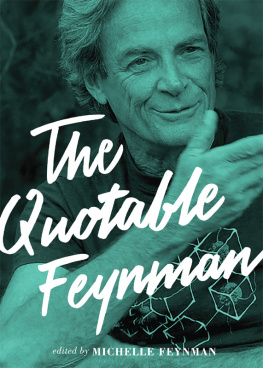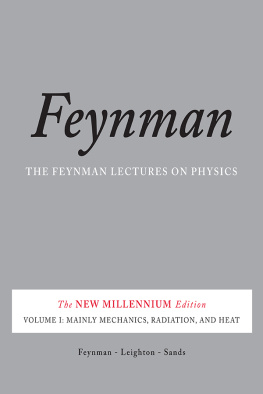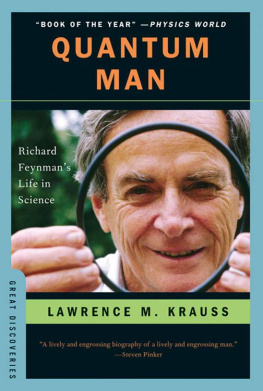PENGUIN BOOKS
THE CHARACTER OF PHYSICAL LAW
Richard P. Feynman was one of this centurys most brilliant theoretical physicists and original thinkers. Born in Far Rockaway, New York, in 1918, he studied at the Massachusetts Institute of Technology, where he graduated with a BS in 1939. He went on to Princeton and received his Ph.D. in 1942. During the war years he worked at the Los Alamos Scientific Laboratory. He became Professor of Theoretical Physics at Cornell University, where he worked with Hans Bethe. He all but rebuilt the theory of quantum electrodynamics and it was for this work that he shared the Nobel Prize in 1965. His simplified rules of calculation became standard tools of theoretical analysis in both quantum electrodynamics and high-energy physics. Feynman was a visiting professor at the California Institute of Technology in 1950, where he later accepted a permanent faculty appointment, and became Richard Chace Tolman Professor of Theoretical Physics in 1959. He had an extraordinary ability to communicate his science to audiences at all levels, and was a well-known and popular lecturer. Richard Feynman died in 1988 after a long illness. Freeman Dyson, of the Institute for Advanced Study in Princeton, New Jersey, called him the most original mind of his generation, while in its obituary The New York Times described him as arguably the most brilliant, iconoclastic and influential of the postwar generation of theoretical physicists.
A number of collections and adaptations of his lectures have been published, including The Feynman Lectures on Physics, QED (Penguin, 1990), The Character of Physical Law (Penguin, 1992), Six Easy Pieces (Penguin, 1998), The Meaning of It All (Penguin, 1999), Six Not-So-Easy Pieces (Penguin, 1999), The Feynman Lectures on Gravitation (Penguin, 1999), The Feynman Lectures on Computation (Penguin, 1999) and The Pleasure of Finding Things Out (Penguin, 2001). His memoirs, Surely Youre Joking, Mr Feynman, were published in 1985.
RICHARD P. FEYNMAN
THE CHARACTER OF PHYSICAL LAW
WITH AN INTRODUCTION BY
PAUL DAVIES

PENGUIN BOOKS
PENGUIN BOOKS
Published by the Penguin Group
Penguin Books Ltd, 80 Strand, London WC2R 0RL, England
Penguin Putnam Inc., 375 Hudson Street, New York, New York 10014, USA
Penguin Books Australia Ltd, 250 Camberwell Road, Camberweil, Victoria 3124, Australia
Penguin Books Canada Ltd, 10 Alcorn Avenue, Toronto, Ontario, Canada M4V 3B2
Penguin Books India (P) Ltd, 11 Community Centre, Panchsheel Park, New Delhi 110 017, India
Penguin Books (NZ) Ltd, Cnr Rosedale and Airborne Roads, Albany, Auckland, New Zealand
Penguin Books (South Africa) (Pty) Ltd, 24 Sturdee Avenue, Rosebank 2196, South Africa
Penguin Books Ltd, Registered Offices: 80 Strand, London WC2R 0RL, England
www.penguin.com
First published by the British Broadcasting Corporation 1965
Published with a new Introduction in Penguin Books 1992
19
Copyright Richard P. Feynman, 1965
Introduction copyright Paul Davies, 1992
All rights reserved
Except in the United States of America, this book is sold subject to the condition that it shall not, by way of trade or otherwise, be lent, re-sold, hired out, or otherwise circulated without the publishers prior consent in any form of binding or cover other than that in which it is published and without a similar condition including this condition being imposed on the subsequent purchaser
ISBN: 978-0-14-195611-4
Introduction
It is fashionable for historians of science to dwell on the significance of scientific revolutions. Each revolution comes with a cluster of so-called geniuses, men and women whose skill and imagination force the scientific community to break out of old habits of thought and embrace new and unfamiliar concepts. Genius is a much studied phenomenon. Less attention is given to the importance of what might be called style. However, changes in work style can have as big an impact on scientific progress as conventional genius.
Richard Feynman had both genius and highly unconventional style. Born in 1918, he was too late to participate in the Golden Age of physics, which, in the first three decades of this century, transformed our world view with the twin revolutions of the theory of relativity and quantum mechanics. These sweeping developments laid the foundations of the edifice we now call the New Physics. Feynman started with those foundations and helped build the ground floor of the New Physics. His contributions touched almost every corner of the subject and have had a deep and abiding influence over the way that physicists think.
Feynman initially made a name for himself from his work in particle physics, more specifically from the topic known as quantum electrodynamics, or QED. The quantum theory actually began with this problem. In 1900 Max Planck proposed that light and other electromagnetic radiation, hitherto viewed as waves, should be regarded as tiny packets of energy, or quanta, when interacting with matter. These particular quanta became known as photons. By the early 1930s the architects of the new quantum mechanics had worked out a mathematical formalism to describe the emission and absorption of photons by electrically charged particles such as electrons. Although this early formulation of QED enjoyed some success, the theory was clearly flawed, and it was to the problem of constructing a consistent theory of QED that the young Feynman turned his attention in the late 1940s.
To place QED on a sound basis it was necessary to make the theory consistent not only with the principles of quantum mechanics but with those of the special theory of relativity too. These two theories come with their own distinctive mathematical machinery, complicated systems of equations that can indeed be combined and reconciled to yield a satisfactory description of QED. This was the approach followed by Feynmans contemporaries. Feynman himself, however, thought about the problem in a radically different way so radical, in fact, that he was more or less able to write down the answers straight away without using any mathematics!
To aid this extraordinary feat of intuition, Feynman invented a simple system of diagrams that still bear his name. Feynman diagrams are a symbolic but powerfully obvious way of picturing what is going on when electrons, photons and other particles interact with each other. Today they are a routine aid to calculation, but in the early 1950s they marked a startling departure from the traditional way of doing science.
The particular technical problem of QED, although a milestone in the development of physics, merely serves as an illustration of what was to become a distinctive Feynman style, a style that reverberated through post-war physics and triggered dozens of important advances.
The Feynman style can best be described as a mixture of reverence and disrespect for received wisdom. Physics is an exact science, and the existing body of knowledge, while incomplete, cant be just shrugged aside. Feynman acquired a formidable grasp of the accepted principles of physics at a very young age, and he chose to work almost entirely on conventional problems. He was not the sort of genius to beaver away in isolation in a backwater of the discipline and to stumble across the profoundly new. His special talent was to approach essentially mainstream topics in an idiosyncratic way. This meant eschewing existing formalisms and developing his own highly intuitive approach. Whereas most theoretical physicists rely on careful mathematical calculation to provide a guide and a crutch to take them into unfamiliar territory, Feynmans attitude was almost cavalier.
Next page

